This is my second blog post about pencils that The Pen Company sent to me [1]They send pens to several bloggers. You don’t have to pay for the pens, but are expected to write a blog post about the pens.. The original blog post can be found on their blog.
Me and Lamy, Lamy and I
You might not have guessed, because of the lack of Lamy posts on Bleistift, but Lamy is one if the stationery brands I feel strongly connected to. It all started about 1985 when I got my first Lamy Safari fountain pen. From that point onwards I only used Safari fountain pens in school. After I left school I didn’t use fountain pens on a daily basis any more and temporarily lost my link to Lamy. I did buy the occasional Lamy pen, though, until finally, in 2008, I rediscovered Lamy as one of my favourite brands after I got a Lamy 2000 fountain pen.
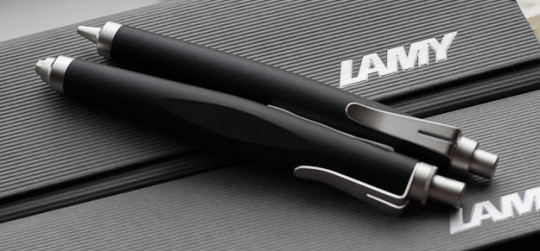
Volker Albus, architect and designer: Just think of his Scribble writing set for Lamy. Seldom have the central functions and haptic requirements of such a twist action pen been translated so precisely and at the same time unmistakably into an aesthetic vocabulary.
Studio Hannes Wettstein (2011, p. 151)
Lamy and pencils
I was quite excited when Lamy’s wood cased pencils came out in 2010, even though, for my taste, they are a bit too soft for daily use. I have also bought a few of their mechanical pencils and I have been tempted on several occasions to buy a Lamy 2000 or Lamy scribble mechanical pencil. So, naturally, I was very excited when I received two Lamy scribble pencils from The Pen Company, the Lamy scribble 0,7 [2]Germany, like most European, African and South American countries, adopted the comma as their decimal mark. Mechanical pencil and the Lamy scribble 3,15 Mechanical pencil. Because of its width I’d actually call the 3.15 mm version a lead holder, but I’ll go with the official name here, according to which it is a mechanical pencil.
The design – the process
First computer designs and prototypes of the scribble were created in 1997 by Swiss designer Hannes Wettstein, one of Switzerland’s most important designers [3]see NZZ: Suche nach den Archetypen von morgen, 7 July 2008. This was followed by two more prototype series in 1998 that lead to the final drawings in 1999. I’ll write more about the design later in this blog post. Overall, the development time of the scribble took less than two years.
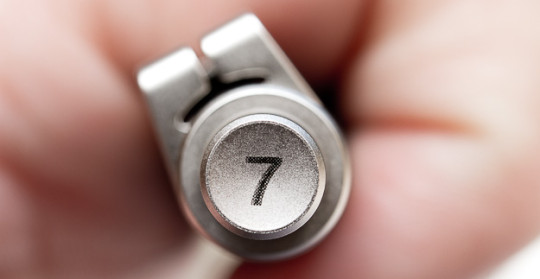
The design – the colours
The current version of the scribble features what I tend to see as a classic colour combination: black and silver. It is a colour combination that I associate with simple design that follows functionality. Interestingly enough many of the great black and silver products I can think of feature a similar distribution between the two colours: lots of black and a bit of silver – and they also try to avoid unnecessary design elements that don’t contribute to the products function.
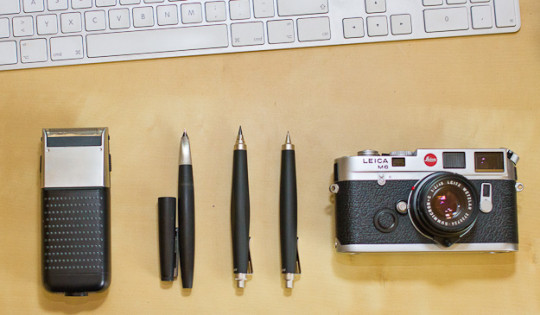
Another version of the scribble was available until 2010. Instead of fittings with a palladium finish it featured fittings in black chrome [4]I’d like to thank Lamy’s Marco Achenbach for this information..
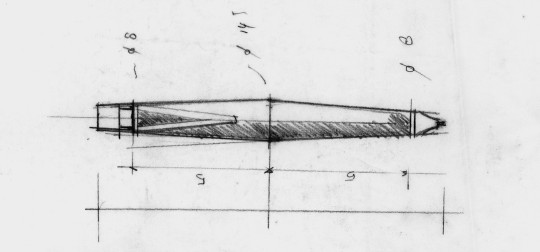
The design – the shape
The bulge in the middle of the short shaft makes SCRIBBLE a highly ergonomic tool. Its ergonomic quality is further enhanced by the flat surfaces, which are cut into the shaft. These flats also prevent the pen from rolling away.
Studio Hannes Wettstein (2011, p. 222)
With 10 mm – 13 mm [5]depending on where you hold this pen diameter the grip section of the scribble certainly has a wider than average diameter. I read in the past that wider grips on pens relieve writing stress and fatigue. I have to emphasise that I didn’t see any such claim from Lamy or Studio Hannes Wettstein, but after having used the scribble for a while I found that writing with another mechanical pencil with a much narrower grip felt much less comfortable, compared to the scribble. Even though the grip section is quite wide the tip is rather slim. This makes it possible to write using with a more acute angle.

The design – awards
It doesn’t come as a big surprise that such an excellent pencil won several awards.
In 2001 the scribble won the Design Plus award in Frankfurt and in 2002it won the if award in Hanover.

The 0.7 mm version
The 0.7 mm version can hold up to 6 leads (if you wiggle the pen a bit to get them all in). It also features a small eraser under the cap that comes with a pin / clean out rod. Each click will advance the lead by about 0.9mm, which is suitable for a 0.7 mm lead.
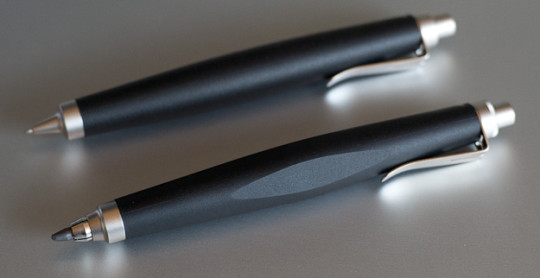
The 3.15 mm version
The 3.15 mm version has three grooves along the body of the pen. I first thought they are there to support rotating the pen to use up the lead evenly, but they are not close enough to the tip for this, so I assume the grooves are there to visually distinguish the 3.15 mm version from the 0.7 mm version version of the pen. The pen comes with a 4B lead. a bit soft for my taste and unfortunately Lamy only sells refills in 4B, but you can get harder leads from other manufacturers. I assume that slightly thinner leads, like Caran d’Ache’s 3 mm leads will also fit. As far as I know Lamy does not offer a suitable sharpener. So far I have sharpened the lead using a KUM Automatic Long Point sharpener.
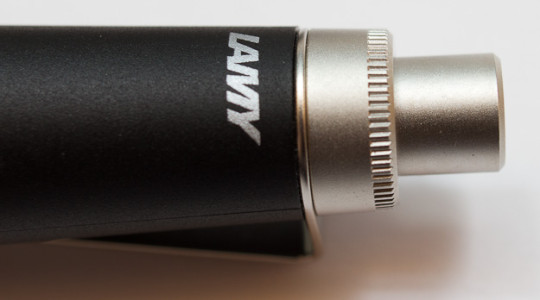
Clip and mechanism
Both pens feature a sheet metal clip that can be removed. With 0.65 mm the sheet metal clip is thicker than that of your average pen. Most clips are bent on the corners to give the illusion of volume, but the scribble‘s clip is really that thick. According to Simon Husslein from Studio Hannes Wettstein designing and producing this clip was quite a challenge. I certainly believe that as I was not able to find another pen in my collection with such a thick sheet metal clip.
The lead holding mechanism seems to come from Schmidt. It is featured on page 12 of their catalogue – it’s the second mechanism from the left. The mechanism works very well, but my exposure to lead holders is limited, so I can’t really compare it.
There is also a ball point version available. This seems to be an afterthought that was designed in December 2000. The body is based on the 0.7 mm version body, the one without the grooves.
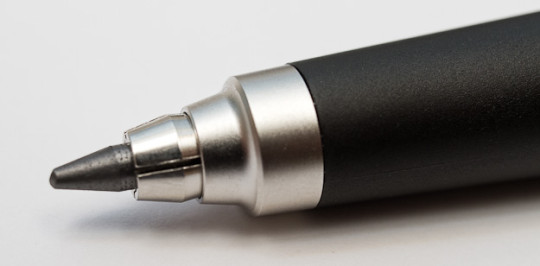
Hannes Wettstein post scribble
Hannes Wettstein and his studio later also went on to develop the studio for Lamy, which makes him one of the few select designers who designed more than one pen for Lamy. Hannes Wettstein died in 2008, but his design lives on. Current products by Studio Hannes Wettstein are created by Simon Husslein and Stephan Hürlemann and are very close to Wettstein’s design DNA. Look at this Braun watch for example.
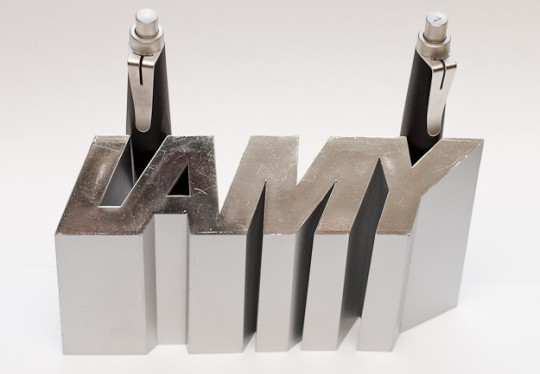
Conclusion
It didn’t take long for these two mechanical pencils to become my current favourites. There are other pencils that I like for their design, but I love the scribble because it’s so comfortable to hold (the grip diameter is surprisingly comfortable and the weight distribution is very good, too) and looks so good. It’s just a shame there’s no 0.5 mm version available, but my understanding is that as users of the scribble Hannes Wettstein had architects and designers in mind who want to liberally put their drawing lines on a blank canvas. A thin line just isn’t suitable for that purpose.
I’s like to thank Simon Husslein from Studio Hannes Wettstein for answering all my questions about the scribble patiently. All the information about the design process came from Mr Husslein.
You can find more information about the Lamy scribble at Pencil Revolution, Jack the Scribbler (ballpoint version) and Dave’s Mechanical Pencils.
Only slightly related: There’s a great article on the Fountain Pen Network: Lamy 2000 and the Origins of “Lamy Design”
The quotes in this blog post have been taken from the following book:
Studio Hannes Wettstein. Seeking Archetypes. 2011. Lars Müller Publishers, Zürich.
References
| ↑1 | They send pens to several bloggers. You don’t have to pay for the pens, but are expected to write a blog post about the pens. |
|---|---|
| ↑2 | Germany, like most European, African and South American countries, adopted the comma as their decimal mark. |
| ↑3 | see NZZ: Suche nach den Archetypen von morgen, 7 July 2008 |
| ↑4 | I’d like to thank Lamy’s Marco Achenbach for this information. |
| ↑5 | depending on where you hold this pen |
You mention Lamy woodcase pencils. I’ve never seen them here in the USA. What do they look like, etc.?
Thanks for your comment.
You can see them on Lexikaliker’s blog at http://www.lexikaliker.de/2010/04/lamy-plus/
Congratulations for the blog post and the picture Black and Silver.
I didn’t like Lamy until now, i prefer pencils to be thinner, plus i don’t like angled surfaces on writing instruments. They are very demanding on the hand if you write for a longer period. But… the picture with the Leica M6, the old Braun shaver and the Lamy made me like it and want it.
I could not see beyond the fattines of their products, but the picture showed me and made me understand where is the design inspired from. It’s like Cinderella :))
Enjoy your new pencil
Rares, I think that must be the highest praise I ever received on this blog. Thank you very much!
I really enjoy these pencils – despite normally preferring thinner leads. If you buy one I hope you’ll enjoy it, too!
Matthias, I think the grooves of the 3.15 mm version high up on the middle of the body facilitate the way an artist would use the scribble to tone and shade large areas of his drawing — he would grip it in the middle and hold it flatter to the surface, accessing more of the lead. Just a guess.
Junius, that is interesting. Do I understand this right – the purpose is the be able to hold the pen more parallel to the paper? Does that mean that the lead has to be extended a lot to allow for that?
Yes, that is my speculation, the grooves would allow the artist to control the fat part of the pencil, and yes I think that’s right, the lead would have to be more extended — the point wouldn’t necessarily be conical, either — it might be a chisel-shaped or square (sorry for the late response).
Matthias, I meant to clarify that my comment refers to the 3.15 mm version. The excerpt from page 222 that you reproduce above touts how the grooves enhance the ergonomics of the middle. Even though it is short in length I don’t think people would grasp the scribble that far up for handwriting — this is why I think Lamy had something more in mind with those grooves (the 0.7 mm scribble dispenses with this aid).
Junius, thanks for this further explanation. I’m still not 100% sure I understand it completely, but I think that’s because I’m not familiar with different drawing techniques. Also, if you use a chisel shape or another shape then the groves might help keeping an exact angle. Giving the groves a purpose, rather than them only being a design element, fits this pencil so well.